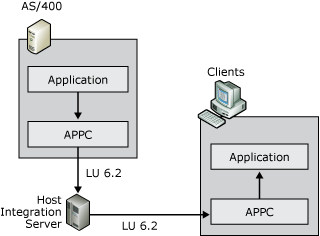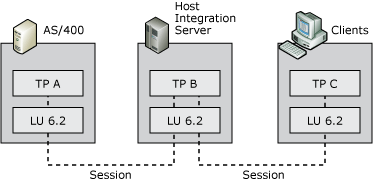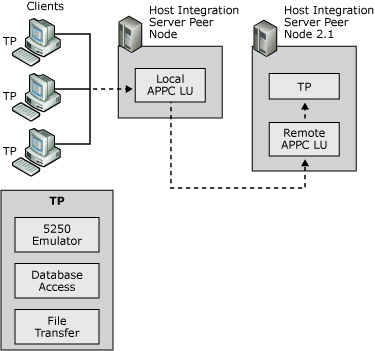Understanding Peer-to-Peer Networking
Devices in peer-oriented SNA networks participate in Advanced-Peer-to-Peer Networking (APPN). Each device, known as a type 2.1 physical unit (PU 2.1), handles all network routing functions, as well as normal computing activities and applications.
LU 6.2 logical units are associated with PU 2.1 devices. Devices in an APPN network appear as LU 6.2 (also called APPC LU) entities. Programs that are executed on these devices are called transaction programs(TPs).

Diagram of peer-oriented SNA network
APPC enables TPs on different APPN systems to communicate directly with each other across an APPN network. In APPN networks, Host Integration Server provides support for the APPC protocol and emulates a PU 2.1 low-entry networking (LEN) node.
In the IBM i environment, APPC is used for a variety of applications, including:
5250 access
TN5250 access
File transfer
TPs use LU 6.2 names to access other systems and other transaction programs as shown in the following figure. With Host Integration Server, a transaction program, such as a 5250 terminal emulator, can also use an APPC LU alias to access another TP. In this case, the LU alias maps to an LU name that is actually used to access the other system's TP.

Diagram of transaction programs in APPCAPPC uses pairs of LUs to facilitate simultaneous, bi-directional communication between transaction programs. To achieve this, a local LU and a remote LU are defined on each device in the APPN network.
The perception of local and remote LUs is dependent on the system that you are configuring. When configuring Host Integration Server, the local APPC LU corresponds to the Host Integration Server computer and the remote LU corresponds to the IBM i. Local LUs on one system communicate with remote LUs on another system. If you view the configuration from an IBM i perspective, the Host Integration Server computer is the remote system and the IBM i is the local system.

Diagram of conversation components in APPCWhen a client/server network TP, such as a 5250 terminal emulator, requests a conversation with a TP on the IBM i (remote system), the server (local system) acts on behalf of the client request and negotiates an LU 6.2 - LU 6.2 session to the IBM i. The data sent or received from the IBM i TP is handled by the server and sent to the client TP over the selected client/server protocol. This is illustrated in the preceding figure.